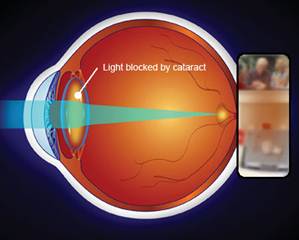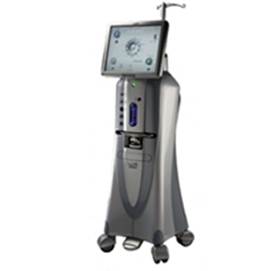When our grandparents had cataract surgery, it was a procedure which was often delayed until they were nearly blind and there was no choice other than undergoing surgery. With advancements in surgical approach and technology available to us, the nature of this surgery is vastly different.
Cataract surgery is now a refractive surgical procedure and is able to offer far better refractive and visual outcomes, with significantly less risk, than was ever the case in the past. As such we are able to offer this surgery to our patients, as soon as they have sufficient symptoms related to cataract which are hampering their lifestyle. Why wait until you have to stop driving before you have your surgery?

For the last 20 years, we have been able to offer our patients cataract surgery with a small ultrasonic probe (phacoemulsification surgery) and this has been the best technique for both cataract and clear lens surgery.
Prior to the surgery, you would undergo a careful assessment to work out the most appropriate lens implant. On the day of surgery, expect to be with us for about 3 hours in total. During this time you will have drops (or a small pledget) inserted into the eye to dilate the pupil. The eye is padded at the end of the procedure and the eye pad can be removed the following morning. Vision improvement is often noticed when the pad is removed, although the vision can be a little blurred for a few days. Several eye drops need to be instilled periodically for 3 to 4 weeks after the surgery
What does the surgery involve?
On the day of surgery and once in the clinic your pupil will be dilated with either drops or a small pledget placed just inside the lower eyelid. The area around your eye will be washed and cleansed. The operation typically takes as little as 10 minutes and is painless as it is usually performed under a local or topical anaesthetic.
Traditionally, the technology used is a machine called a phacoemulsifier (phaco). The surgeon makes a micro-incision on the side of the cornea, no more than 2.85mm, and inserts a tiny probe into the eye. This ‘phaco’ device emits ultrasound waves that soften and break up the cloudy lens. It is then removed by suction.
Once removed the original cataractous lens is replaced by a lens implant which is folded, and inserted through the tiny incision. It then unfolds once in place in the eye. There are usually no stitches, and you can return home the same day and look forward to a rapid and pain-free recovery.

How long will the surgery take?
The operation itself will take up to 10-30 minutes depending upon the complexity of the case. However you will need to plan to be in the clinic/hospital for upto 3 hours. You will need someone to collect you, or transport can be arranged for you, in advance.
What happens after the operation?
After the operation you will rest for a while and have refreshments. You will be given a dressing pack to swab the eye clean the following day, and some antibiotic and anti-inflammatory eye drops to apply at home after the surgery, for 2-4 weeks.
How quickly will my vision be restored?
Your vision will be slightly blurred for a few days while your eye heals. It is usual to feel some discomfort until your eye settles but there should be no pain. Any discomfort can be eased by taking paracetamol. After a couple of days you will start to notice a significant improvement in your vision. You will see the surgeon again after 5-10 days and may visit your optometrist for new glasses after 4-6 weeks (unless you are due to have second eye surgery). You can quickly return to many everyday activities, although heavy lifting or other strenuous activities should be avoided for at least 2 weeks. The healing eye needs time to adjust so that it can focus properly with the other eye, especially if the other eye has a cataract. Ask your surgeon or optometrist when you can resume driving.
What will my vision be like after my eye has healed?
Once you have been given your new glasses, you may notice that everything seems a lot brighter than you remember. Colours may be sharper and may have a blue-ish tinge. Or, in bright sunlight, you may feel you are looking through rose-coloured glasses. These colour tinges are normal and are because you are now looking at the world through a clear lens that is no longer cloudy. Within a few months your brain will get used to your new clear vision and these colours should go away.
Can I have both eyes done at once?
If you have cataracts in both eyes, the surgeon will not usually remove them both at the same time. You will need to have each done separately, although they can both generally be done within about 1-6 weeks of each other.
What are some of the risks of cataract surgery?
Your Consultant has performed thousands of cataract operations. Manchester Eye Surgery Ltd ensure that the technology and products used for the surgery are of the highest standards available. Although the vast majority of patients achieve excellent results without complications, it should not be forgotten that cataract removal is a surgical procedure. As with all forms of eye surgery, cataract removal has risks and whilst we make every effort to minimise them, they cannot be totally eliminated. The most common and potentially serious risks associated with the cataract operation are:
- Retinal Detachment – occurs when the retina detaches from its normal position and can result in severe loss of vision if surgical correction is not successful. The approximate risk of a retinal detachment in the general population is 0.01 % per year. Someone who is hyperopic has a smaller risk than this, whereas a myopic patient has a slightly higher risk than this.
- Infection – every time there is an incision made in an eye for any reason it is possible to get an infection inside the eye which has the potential to cause severe visual loss. This problem is very rare and our rate of endophthalmitis is less than 0.1%. After the cataract operation, to help protect against infection, eye-drops are prescribed which must be used as directed.
- Bleeding – there is a small risk of a serious peri-operative bleed either in the orbit, or within the eye itself.
- Macular Oedema – is an accumulation of fluid at the central retina which can cause temporary or permanent reduction in vision after surgery. The postoperative eye-drops help to reduce this risk.
- Floaters – are often noticeable immediately after surgery but usually become less noticeable with time.
- Posterior Capsule Opacification (PCO) – is thickening of the residual lens membrane which supports the lens implant. Approximately 25-30% of patients will, at some stage, notice a reduction in their vision due to PCO. It may occur months or even years after surgery and is easily and quickly dealt with by outpatient laser treatment.
- Specialised multifocal lens implants (e.g. toric, accommodative, multifocal, or toric multifocal) may present other risks/side effects which your surgeon will discuss with you
- Other possible complications include tearing of the lens capsule (<1%) which could mean that it is more difficult to implant an intraocular lens. There are other extremely rare complications which your surgeon can discuss with you prior to surgery.
How long does the implant last?
The lens implants used are generally left in place for life.
Can a cataract come back?
Once you have a replacement lens implant (intra-ocular lens or IOL as it is commonly called) you cannot develop another cataract in that eye. However, it is quite common for the membrane that holds the lens in place to develop some cell re-growth in the first 12-36 months after surgery. Should this occur, it is easily and painlessly removed in seconds using a small laser beam in the surgeons consulting rooms. This technique is called YAG laser capsulotomy and is a relatively simple outpatient procedure.
What if I don’t want to have an operation for my cataract?
Cataracts develop usually with age. The process is a progressive one and cataracts do not go away of their own accord. If you have cataract and it is causing you significant symptoms, or you are concerned it may interfere with your ability to drive, then the only realistic, long-term solution is cataract surgery. For some people, changing spectacle prescription may be beneficial as a short-term measure. However, it is not unusual for several spectacle changes to be necessary over a short period of time. This is both expensive and frustrating. There is no other effective treatment, for cataract, apart from surgery in the hands of a specialist ophthalmic surgeon.